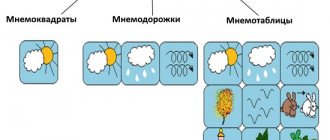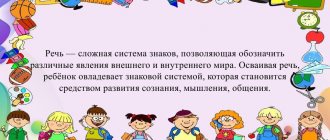One of the main and fundamental conditions for the comprehensive and full development of children during preschool age is competent, logically structured, beautiful speech. As a rule, it is during preschool age that the optimal and most favorable conditions for the formation of eloquence and a full-fledged vocabulary develop.
According to many speech therapists, in order to help children quickly absorb new information and develop, learn to logically express their thoughts, and talk colorfully and interestingly about themselves and the world around them, specially created techniques and communication techniques are used. And one of these techniques is the use of mnemonic tables in the development of children’s speech.
Common speech problems in preschool children
In most cases, girls and boys of preschool age should already be able to fully operate with synonyms and a variety of images, describe all current events, using vivid, but at the same time grammatically correct word forms. But, unfortunately, not all preschoolers can boast of such skills. Most children face various speech problems:
- Inability to compose long, complex sentences - the child’s speech consists exclusively of simple, laconic sentences.
- The child cannot independently formulate a logically correct and complete sentence.
- Systematic use of non-literary vocabulary.
- Minimal, poor vocabulary that does not correspond to the child’s age category.
- A preschooler cannot independently formulate questions and answer questions posed.
- Poor level of diction.
- A preschooler cannot draw correct logical conclusions and statements.
To correct such speech defects, mnemonics are often used, which have become widespread among many specialists.
What is mnemonics?
Mnemonics – literally translated from Greek means “the art of memorization.” This is a certain system of techniques and methods, the action of which is aimed at the most effective preservation, reproduction and memorization of the received material.
The name of this technique is absolutely no coincidence - it comes from the name of the ancient Greek goddess of memory, logic and prudence named Mnemosyne. Mnemonics is a popular technique, the essence of which is the most accelerated development of coherent speech, based on the visual perception of information with its further reproduction using images.
The main point of using a mnemonic table for children is the following: to determine a specific word or phrase, a specific image (picture) is used, with the help of which a schematic sketch of the word is made. By carefully studying the presented images, the child can quickly memorize and reproduce text material, which helps the development of speech for preschoolers.
Improving speech in the preparatory group of preschool educational institutions using tables
Unprepared preschoolers with poor, illiterate speech have difficulty mastering school knowledge. The oldest kindergarten students are a little less dependent on visualization than younger preschoolers. But mnemonic tables are still a necessary method of cognition.
Preparing speech for learning to read and write: mnemonics
Mnemonics help prepare a child to master literacy. The child practices constructing sentences and dividing them. It is worth considering the difficulties of the initial stages of working with pictures:
- the stories are unemotional and schematic;
- poor vocabulary;
- the sentences are fragmentary, uncertain, reminiscent of a tongue twister.
To neutralize difficulties, the teacher activates and enriches the vocabulary. Older preschoolers work with the material step by step:
- Parse the images.
- Symbols are transformed into images.
- Reproduce the text and make up an original story.
- Draw new mnemonic tables.
- The story is told according to diagrams created by the children.
You can create a table at home by selecting images on the topic
An example of an elementary manual on the topic “River”: the first picture is several waves; the second is a frog; the third is a fishing rod. Using this scheme, you can tell a couple of sentences or a whole fairy tale (older preschoolers).
Important! The content of didactic materials should be appropriate for the age of the children. It becomes more difficult gradually, without overload.
Mnemonic diagrams for speech development for preschoolers should be structured according to the program, exciting, and reflect the values of education. It is necessary to develop such benefits not only with children, but also with parents. They are introduced to technology at meetings and events. The teacher will receive like-minded people and associates who will make the mnemonic table method even more effective. The cooperation of the family with the teacher during the senior year is especially valuable.
Speech development in the younger group - norms for children's speech development by spring
Mnemonic tables for the preparatory group: reading, retelling
First, highlight the central idea of the text in all paragraphs. Icons are invented to convey this idea. For small texts, select 1 character for each word.
You can fill the diagram with the heroes of history, natural phenomena. It is worth putting into it what is difficult to remember.
Important! Effective drawings are easy to read and their meaning is clear.
Kids, in addition to drawings, master graphic symbols. An example of simple images in mnemonic tables for junior and middle groups: animals from a triangle (torso), a circle (head). Color accordingly. Complex symbols: black lines, circles, dots, checkmarks. Depending on their age, children can draw diagrams under the supervision of adults or just color them.
Using mnemonic tables for cognitive development
Cognitive development and the factors influencing it are considered by A. M. Leushina and other teachers. For the effectiveness of cognition, the following are important:
- visibility;
- drawing up a plan, sequential placement of components;
- entertaining game.
It’s easy to learn poems using charts and tables
These factors are combined in mnemonic tables, which are considered a visual plan of information. Kids come up with points and sequentially encode them in images. This is how poems are memorized, fairy tales are composed, the properties of new objects are studied, and information is systematized.
The main advantages of mnemonic tables
The use of mnemonic tables in the development of children's speech has become quite widespread among specialists and teachers. The use of this technology can significantly facilitate the learning process for preschool children and maximally accelerate the pace of development of children's coherent speech.
Thanks to the fact that colorful visual schemes are used in the learning process, kids learn to construct grammatically correct, logically complete, consistent and accurate texts, rich in a variety of clarifying details.
Below is an example of a mnemonic table on the topic “autumn”, where the child learns the main features of this time of year.
To summarize, we can say that a mnemonic table for the development of coherent speech is a specific diagram that conveys specific information and acts as a very important visual material for normalizing the full formation of coherent speech in preschool children.
What are the main advantages of mnemonic techniques over other speech development techniques?
- Promotes accelerated development of visual and auditory memory.
- Used to solve common school problems, such as memorizing poems or solving complex riddles and puzzles.
- Mnemonic tables for children are also widely used to develop a preschooler’s skill in retelling any work of fiction.
- In order to improve the conversational skills of a preschooler, as a result of which the child can fully support a conversation on almost any topic.
- Maximum development of speaking skills.
In addition, the timely use of mnemonic tables in the development of coherent speech makes it possible to achieve success in the development of associative thinking, visual perception, auditory memory, and imagination.
What is a mnemonic table
Mnemonic tables are an effective technology for forming coherent speech.
Together with classical methods of speech development, mnemonics are actively used in preschool practice.
Mnemonics are methods and techniques that affect the memorization, storage and reproduction of information. Such a system is based on the creation of certain associations-images that promote the development of memory and coherent speech, manifested in the statements of preschool children in the form of description, narration and reasoning.
For children, this is a complex speech activity, so the methods of work should be accessible and understandable, and arouse their interest. To do this, adults themselves must have a good command of mnemonics in order to use it in the development of coherent speech in preschoolers.
Taking into account the psychological characteristics of children: visual-figurative thinking, involuntary processes of memory and attention, creative imagination, teachers use mnemonic techniques for the correct construction of speech in preschool children. An important place among them is occupied by mnemonic tables, or diagrams with code information. Since in preschool age visual-figurative thinking remains the dominant one, therefore the perception and processing of information will be best built on the basis of visual images.
The use of mnemonic tables is available not only to teachers, but also to parents. Everyone knows that preschool children love to draw, and in their drawings they depict all the objects of the surrounding world, natural phenomena, people who are next to them, the plots of their favorite fairy tales, etc. On this children's desire for creativity, work must be done to teach children mnemonic tables , not forgetting that this activity presupposes the presence of a certain level of thinking and creative skills of the child.
It is best to start with color tables, since images in the minds of children are built on specific properties of objects: if the sky is necessarily blue, snow is white, orange is orange. For older preschoolers, who are already developing logical thinking, it is better to switch to a black and white picture so that the color does not distract the child from the schematic image. This is how children learn the concept of “encoding a word.” Parents should not be scared by this; everyone in life encounters information coding: road signs, school puzzles, algorithms, etc.
Production of mnemonic tables
Making educational mnemonic tables for speech development does not require any special skills or artistic talent. A word or short phrase is selected, as well as an image that will clearly illustrate the selected word.
For children of primary preschool age, it is best to use tables with bright, colorful pictures - thanks to images of a squirrel, bunny or flower, the child remembers the material much faster and easier.
After some time, after the children have carefully studied the phrase and the image that characterizes it, you can replace the picture with graphic symbols. For example, draw a Christmas tree with a green triangle, and a hare with a gray or blue circle. Below is shown how, using the example of the fairy tale “Ryaba Hen,” you can make mnemonic tables with gradual complication in the form of replacing pictures with graphic symbols:
Mnemonic table with pictures only.
Add some graphic symbols.
Replace all pictures with graphic symbols.
Most often, for the development of coherent speech in preschool children, ready-made diagrams and tables developed by V.K. Vorobyova or T.A. Tkachenko. But it is worth remembering that such model schemes cannot be called universal - they can only become the basis in the learning process of each individual child. The teacher can independently refine, improve and correct ready-made model diagrams.
In most cases, educational mnemonic tables are used to teach children the main features of a particular subject. Therefore, the main topics in such tables may be the study of the color, shape, size, texture (soft or hard) of a particular object. In addition, the educational mnemonic table can answer the following question:
- What elements does this item consist of?
- What is this thing used for?
- What can you do with this item and what can’t you do with it?
This is an approximate list of questions that the child should answer after studying cards with images and mnemonic tables.
Mnemonic tables on speech development for older preschoolers
Correctly developed schemes are effective, not cumbersome, and resemble a game.
Speech Problems That Can Be Resolved Using Graphic Charts
Theme “Autumn” in the mnemonic table
Mnemonics solve speech problems:
- Difficulties in diction (including difficulty pronouncing sounds).
- Inability to control the voice (intonation, tempo, volume).
- Inability to build a dialogue (formulation of questions, detailed or short answers).
- Monosyllabic speech (includes only simple sentences).
- Insufficient vocabulary.
- Use of non-literary vocabulary.
- Difficulties during the construction of a monologue (retelling, descriptive or plot story on a specified topic).
- Inability to substantiate conclusions and conclusions.
Mnemonic table with children's hands
Thanks to the technique, the following mental and thought processes are improved, on which correct speech depends:
- memory;
- imagination;
- attention;
- observation;
- ability to compare and highlight key elements.
The essence of mnemonics
Mnemonics are used to develop the ability to remember, recreate information, and strengthen memory. The student perceives the material and reproduces it from the images. The essence of the technique: the baby develops associations between a word (phrase) and a picture. Next, the word is associated with a number of association pictures.
Important! Instead of drawings, symbols are suitable for adult preschoolers.
After mastering the method, the child is able to convey words (texts) schematically and decipher signs. Used by teachers, including speech therapists. This makes it easier to absorb knowledge. Tables are especially valuable when memorizing poetry, retelling texts, and solving logical problems. This is one of the basic techniques for the development of children in the DAO.
Advantages of technology
Mnemonic tables are attention-grabbing symbols and drawings that correspond to the mental characteristics of children (distracted attention, visual-figurative thinking). Advantages of the technique:
Colorful drawings are replaced by graphic symbols
- visualization of logical chains;
- emphasis on the essentials (main steps, historical moments, characteristics);
- availability of parts (for detailed descriptions);
- brightness, capacity, conciseness, holding attention;
- development of creativity, communication, associative thinking, speech.
Admission is in demand not only in DAO, but also in classes with students of any age.
Important! The gradual complication of tables and their diversity broadens one's horizons, improves imagination, and helps to systematize accumulated intellectual baggage.
Independent production of mnemonic tables
The material is purchased and created independently. It is worth taking Tkachenko T.A.’s schemes as a basis. or Vorobyova V.K. They are used as a starting point in creativity or modified, taking into account the individuality of the students. Stages of circuit development:
- Illustrations are selected for the word (draw, find ready-made ones). Bright, detailed pictures will suit kids.
- If the guys remember the drawing, it is replaced with a graphic symbol. For example, a bird is a tick, a squirrel is a brown circle.
- When retelling short works, children are guided by such schemes. These can be drawings, images and symbols, only symbols.
Forming a sound culture of speech: speech corner and tongue twisters
Didactic materials—illustrations—are indispensable when learning about colors, shapes, textures, and sizes. Separate pictures indicate parts of the encrypted item, areas of application, permitted and prohibited actions with it. Lessons with mnemonic tables begin with looking at pictures and talking (kids ask, guess, analyze).
Working with mnemonic tables in class
Methods of cognition using charts-tables
It is important to use the manual correctly in order to develop the necessary skills in children. Sequence of work:
- Examination of bright pictures indicating phrases and words.
- They study a more complex structure - mnemonic tracks (up to 4 consecutive, logically connected pictures). On their basis, the children compose short texts.
- Stage of formation of coherent texts. Thanks to pictures with actions (walking, swimming), verb vocabulary is learned. The emphasis is on the stages of action and their results.
While improving their speech, children try to notice important nuances of images without departing from the essence of the story.
Mnemonic tracks and tables fuel interest in studying the world, hold attention, and help find connections between objects.
Important! These visual diagrams are useful when studying literature, mathematics, nature and other subjects.
Features of using mnemonic tables for teaching children
Today, mnemonics are one of the easy-to-use, easy, convenient and highly effective techniques for the development of coherent children's speech and accelerated memorization of material, which are implemented through schematic mnemonic tables and graphic images.
At the same time, this technique helps to formulate the baby’s speech, replenish his vocabulary with beautiful, complex and correctly constructed phrases and sentences. The essence of all mnemonic techniques is the transformation of textual, verbal information into visual images. Despite the fact that many preschool-aged children perceive their first lessons very painfully, believing that they will not succeed, in the future the children really enjoy the educational process. Not only is it extremely informative, but it is also very interesting, engaging and fun, like a game.
Most often, in the case of using mnemonic tables for the development of coherent speech of preschoolers in preschool institutions, the following scheme is used:
- The teacher shows the children cards with bright and colorful pictures indicating a certain phrase or sentence.
- The next stage is the study of so-called mnemonic tracks. This is a series of pictures, consisting of about four images, with the help of which the child can tell a simple story.
- The most difficult stage is the direct use of the mnemonic table for teaching coherent speech to preschoolers. Thanks to this method, preschool children learn to reproduce longer and more complex stories and stories.
Varieties of mnemonic devices for the development of coherent speech in preschoolers:
- Cards with an algorithm for certain actions - for example, the sequence of morning activities (washing, brushing teeth, breakfast, getting dressed).
- Mnemonic tracks with a series of different images that tell a specific story or story. For children of primary preschool age, fairy tales are most often used.
- Techniques for faster and easier assimilation of information and study of poetry.
An example of using the fairy tale “The Three Little Pigs”.
An example in the use of a poem.
Examples of mnemonic tables for preschoolers
- Mnemonic tables for learning poems
To make it easier for your child to remember the poem, you can use mnemonic tables:
- Read the poem to your child with expression.
- Then you need to tell your child that now you will learn the verse by heart together. After this, read the text again, but at the same time pay little attention to the table.
- Discuss the content of the poem, its main idea.
- Find out whether all the words and pictures are clear to the child, explain their meaning.
- Read line by line and ask your child to repeat after you, based on the pictures.
- Then the baby can try to recite the poem on his own, looking at the mnemonic table.
You can see an example of memorizing a poem using mnemonic tables in the video:
- Learning to retell and compose a story based on a diagram
Preschool children, although they have a fairly extensive vocabulary, often have difficulty composing stories. Kids are easily distracted, confused, and lose the logic of their thoughts. Mnemonic tables help children plan a story and reproduce plot events in the correct order.
Basic rules of development using mnemonic tables
When using mnemonics for the development of the speech apparatus in preschool children, it should be remembered that most children, without prior training, perceive this teaching method extremely difficult. At the very initial stages of the educational process on speech development for preschoolers, it is best to use mnemonic squares that are more understandable and easy to understand.
Pictures in black and white are unlikely to be of interest to young children, so it is necessary to use colorful images in bright colors.
The number of pictures in the mnemonic track should not be excessive, as this makes it difficult for the child to perceive any information. The maximum allowed number of images in a track should not exceed 8-9 pictures. And, of course, all tables should not duplicate the same topic - they should all be different and relate to completely different areas.
Making mnemonic tables
The mnemonic table can be drawn by hand or made up of pictures, like a collage. At the initial stage of learning, it is better to draw small ribbon tables, placing 3-4 pictures in a row. Children are interested in coloring these pictures, and later they can give you their own ideas for drawing.
To create a mnemonic table, you need:
- Break the story into parts, identifying important points (every 2-3 words), draw a sheet of paper into squares;
- Draw a picture for each such moment (describing nouns or adjectives);
- If possible, depict unclear words (verbs or questions) somehow or simply put a “?” sign. The child will need to comment on this.
Various riddles or fairy tales are easier and more fun for young children if they are analyzed in situations and depicted in pictures. Then the child is asked to remember what was described and tell it step by step, looking at the pictures.
At the same time, the following processes occur in the child’s head:
- Looking at pictures and understanding what is shown in them;
- Recoding information from visual to figurative, comparing a picture with a concept;
- Compiling a story from pictures;
- Memorizing a story or poem.
A child in the senior group of kindergarten can independently draw pictures for a mnemonic table after the teacher has broken the story down into situations and told him what to draw. You can draw a mnemonic table for the seasons in a simple and interesting way. Here is a description of winter:
It is better to start working using mnemonic tables with children from the age of 4 years, when they have already developed an initial vocabulary. At this age, you can teach children rules based on tables. These can be algorithms for dressing or washing; there are also mnemonic tables for traffic rules so that the child quickly learns the rules of the road.
Children will enjoy learning fairy tales or poems using the tables:
Our Tanya is crying loudly, She dropped a ball into the river. Hush, Tanya, don't cry! The ball will not drown in the river.
As soon as the child understands the purpose of the mnemonic tables, you can increase the number of pictures, as well as the complexity of the task:
You can make puzzles, riddles or mnemonic tables in mathematics. In the latter case, it is enough to draw a number, and in another square a picture depicting this number. Subsequently, the child retains the corresponding picture in his memory when he sees a number.
If you cannot or do not have time to draw mnemonic tables, you can easily find them on the Internet and download them, then print them and practice with your child. It is better not to show it on a computer; the child will not perceive the screen in the same way as the piece of paper in front of him.
Learning results through mnemonic tables
In the vast majority of cases, learning and speech development through mnemonic tables in preschool children is successful. Children significantly expand their horizons and knowledge about the world around them, their imagination noticeably develops, they begin to actively come up with their own plots and entertaining stories.
The children develop an increased interest in various poems and obtain new information about the world around them, their vocabulary expands, and they become ready to speak in front of audiences.
Mnemonics of coherent speech for preschoolers is a popular and widespread technique, the action of which is aimed at improving the procedure for memorizing material, developing associative thinking and beautiful, competent coherent speech.








